Rim Rock Crowned Snake
Tantilla oolitica
Rim rock crowned snakes made news in 2022 when a hiker discovered one of these rare snakes had died while attempting to swallow a centipede!
Advertisement
Rim Rock Crowned Snake Scientific Classification
- Kingdom
- Animalia
- Phylum
- Chordata
- Class
- Reptilia
- Order
- Squamata
- Family
- Colubridae
- Genus
- Tantilla
- Scientific Name
- Tantilla oolitica
Read our Complete Guide to Classification of Animals.
Rim Rock Crowned Snake Conservation Status
Rim Rock Crowned Snake Facts
- Prey
- Invertebrates including centipedes, beetle larvae, earthworms, snails, and spiders
- Name Of Young
- Hatchling, snakelet
- Group Behavior
- Solitary
- Fun Fact
- Rim rock crowned snakes made news in 2022 when a hiker discovered one of these rare snakes had died while attempting to swallow a centipede!
- Biggest Threat
- Habitat loss
- Most Distinctive Feature
- Black head and solid-colored body
- Other Name(s)
- Miami black-headed snake, centipede snake, blackhead snake
- Age Of Independence
- Hatching
- Litter Size
- 1-4
- Lifestyle
- Nocturnal
- Common Name
- Rim rock crowned snake
- Number Of Species
- 1
- Location
- Miami-Dade county in Florida and Monroe county in the Florida Keys
Rim Rock Crowned Snake Physical Characteristics
- Color
- Brown
- Black
- Tan
- Skin Type
- Scales
- Length
- 7-9 inches
- Venomous
- No
- Aggression
- Low
View all of the Rim Rock Crowned Snake images!
Rim rock crowned snakes are endemic to a tiny area of southeastern Florida, and scientists know very little about how it lives.
Tiny, endangered, and ground-dwelling, rim rock crowned snakes recently made scientific and national news because a hiker discovered one that had died while attempting to swallow its prey.
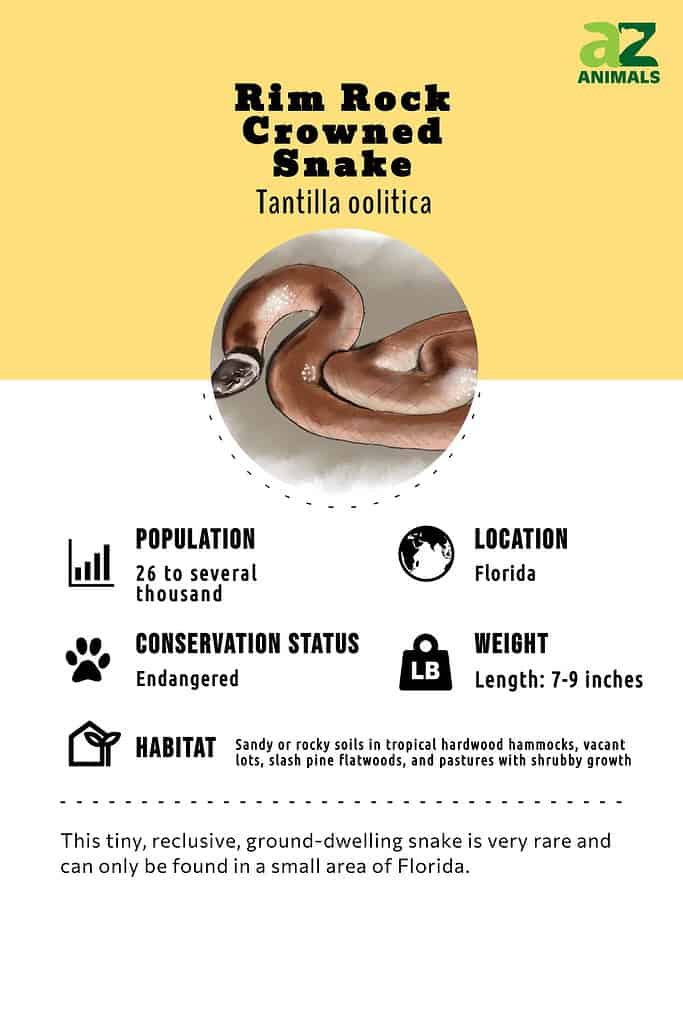
3 Incredible Facts About Rim Rock Crowned Snakes
- These fossorial snakes are hard to study because they spend most of their lives underground.
- One suffocated on a centipede, and researchers did a CT scan on it.
- Most of their native habitat has been replaced with real estate developments.
Scientific Name and Classification
The scientific name of the rim rock crowned snake is Tantilla oolitica.
This species is a member of the Colubridae family. This enormous family of snakes includes both harmless and deadly species, such as king snakes, indigo snakes, boomslangs, and twig snakes.
Rim rock crowned snakes are in the Tantilla genus, which holds about 65 of these harmless fossorial colubrids. In addition, they go by a few other common names, such as centipede snakes, blackhead snakes, and flathead snakes. Its specific name, oolitica, refers to the oolitic limestone rock prevalent in the formerly vacant lot where they found the original type specimen.
This snake’s common name of the rim rock crowned snake comes from its native range, the Miami Rim Rock formation. Some people also call it the Miami black-headed snake. However, scientists described this newish species in 1966 from a specimen found in 1955 in a vacant lot in Miami, Dade County, Florida.
The Tantilla genus is widespread across the New World in North, Central, and South America. They are so reclusive that some species are only known from a single specimen. They are small snakes that spend almost all of their lives underground or under leaf litter. The southeastern crowned snake (Tantilla coronata) is so similar that some scientists think the rim rock crowned snake may be a subspecies, but there’s so little data that it will take more time and research to decide for sure.
Similar snakes are ground snakes, king snakes, and rosy boas.
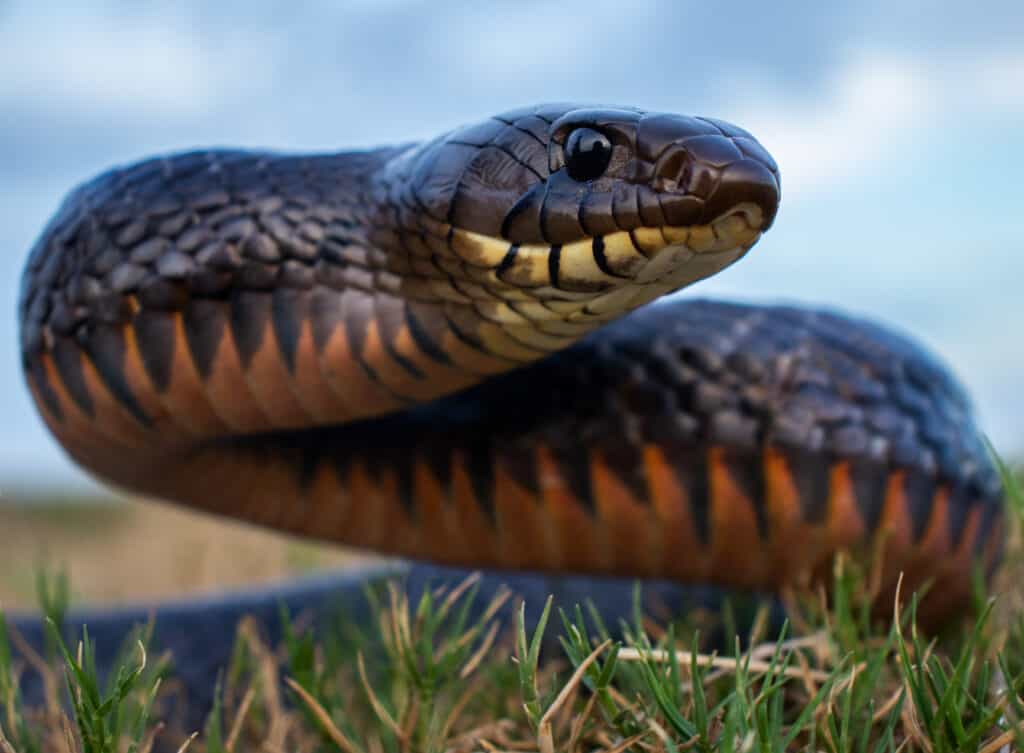
The rim rock crowned snake belongs to the Colubridae family, as does the indigo snake.
©Radiant Reptilia/Shutterstock.com
Evolution and History
As there is very limited information available about the rim rock crowned snake, it’s extremely difficult to determine its origins and history.
We do know that as a member of the Colubridae family, which contains the largest number of snakes, this species’ ancestors — the earliest colubrid snakes — can be traced to the Oligocene Epoch, between 33.9 million to 23 million years ago.
As this snake is a fossorial species, meaning it spends most of its time underground, its evolution likely involved the adaptation of digging or burrowing in soil. Examples of fossorial species include the smooth earth snake, badgers, naked mole-rats, and bees. Evidence of fossorial animals goes back as to the late Ordovician period more than 440 million years ago.
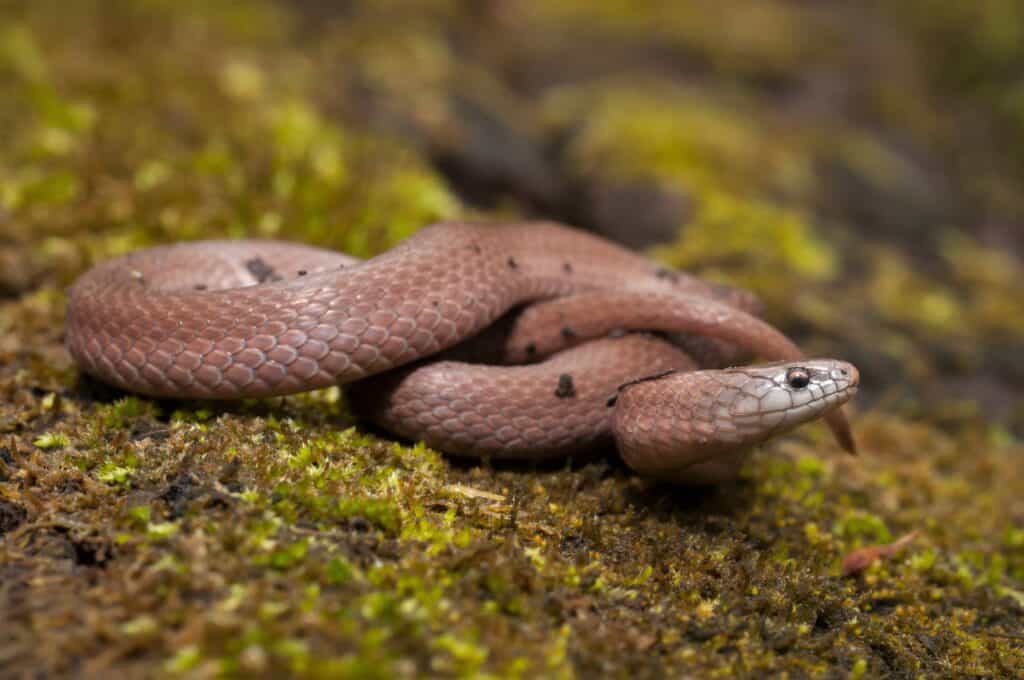
The rim rock crowned snake is a fossorial species like the smooth earth snake.
©Mike Wilhelm/Shutterstock.com
Appearance and Behavior
This tiny colubrid is thin, with a small black head and even smaller teeth. While technically, they’re rear-fanged and do have mild venom, they’re harmless to people and pets. The mainland individuals typically have a solid black head, whereas those found in the Florida Keys often have a white band at the neck that splits the black into two sections. Its body is usually an even brown to tan color with a white belly. Rim rock crowned snakes have smooth, glossy scales that shine with iridescence — when they come out from their underground homes. Unfortunately, these snakes only measure 7-9 inches as adults, so the odds of even seeing one are remote.
These snakes are fossorial, meaning they spend most of their time under the ground or in leaf litter. Unfortunately, this shy snake’s lifestyle makes studying it difficult. If you happen across one of these and try to pick it up, the rim rock crowned snake will release an awful-smelling musk as a defensive mechanism, but it’s not likely to bite.
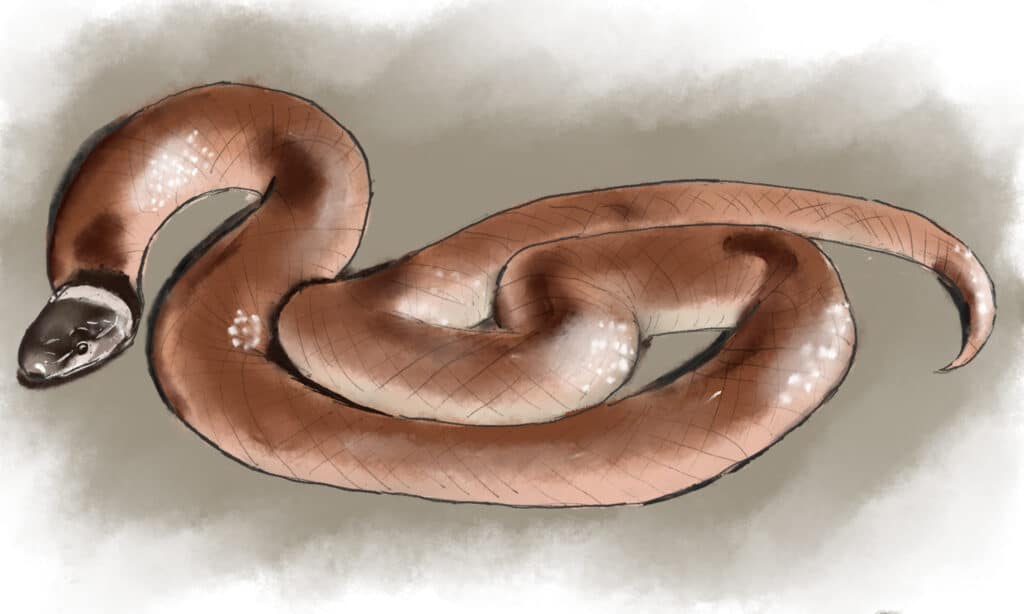
Habitat
This species is native to the southeastern coastal areas of Florida and part of the Florida Keys. They aren’t found anywhere else in the world.
Rim rock crowned snakes inhabit sandy or rocky soils in tropical hardwood hammocks, vacant lots, slash pine flatwoods, and pastures with shrubby growth. They hide under discarded boards, rocks, fallen palmetto leaves, and other debris. A pile of collected leafy-shrubby debris is probably a perfect place for one of these little snakes.

The rim rock crowned snake is found only in Florida.
©Ingo70/Shutterstock.com
Diet
Life in the dirt gives this snake the perfect opportunity to hunt what researchers believe is their favorite prey, invertebrates. However, no one had any factual observations because they are notoriously difficult to observe in the wild. Until a hiker discovered the results of an epic micro-battle between a centipede and a rim rock crowned snake, most items on their dietary menu were educated guesses.
Scientists still know very little about their diet; however, like others in their genus, they probably eat small invertebrates like centipedes, spiders, snails, and beetle larvae.
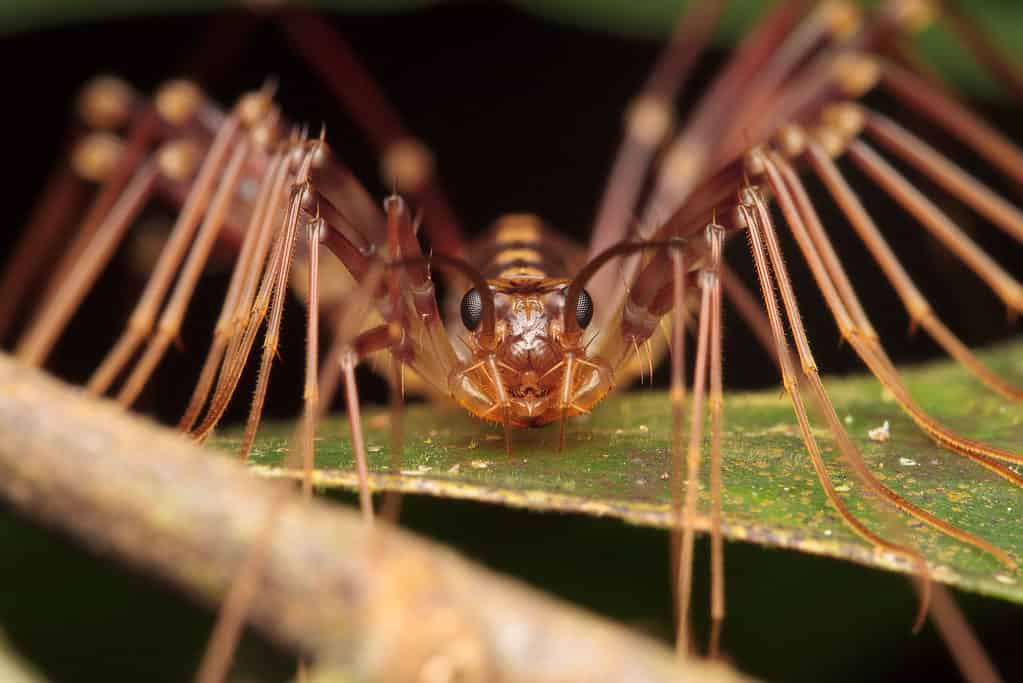
Rim rock crowned snakes have been known to eat centipedes.
©Ron Eldie/Shutterstock.com
Predators and Threats
Small snakes like this tend to have a pretty long list of predators. Any carnivore big enough to grab one of them will do so; this includes birds, cats, larger snakes such as the coral snake, and the slender brown scorpion. Their best defense is to stay hidden, something they’re great at doing.
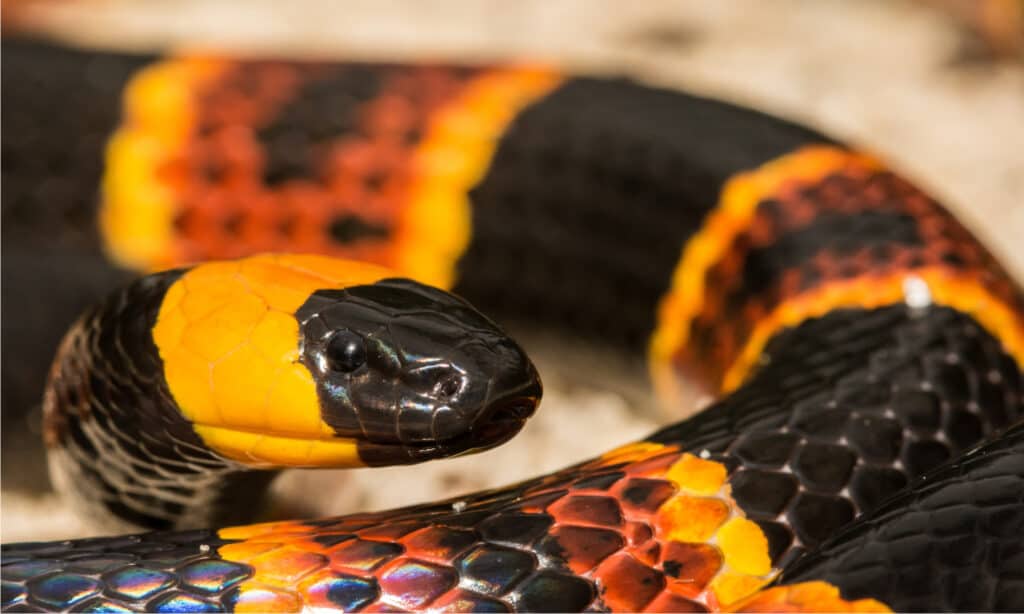
Coral snakes including the eastern coral snake are one of the rim rock crowned snake’s predators.
©Jay Ondreicka/Shutterstock.com
Reproduction and Lifespan
Like other aspects of this snake’s life, there is almost no information on its reproductive habits and lifespan. We know it’s an egg layer, and based on its very close cousin, the southeastern crowned snake (Tantilla coronata), it probably lays 1-4 eggs per clutch.
Conservation and Population
According to the Florida Museum, the species is so rare that the state of Florida has considered it threatened since 1975, just nine years after it was described.
The IUCN Redlist of Threatened Species lists the rim rock crowned snake as “Endangered,” but scientists don’t know much about their population. The 2007 study cited rapidly shrinking habitats and a severely fragmented population as major issues.
No one knows exactly how many of these snakes are out there, with very few individuals of the species having been seen. Yet, due to their reclusive behavior, there are usually quite a few more Tantilla genus snakes than observations indicate. The Florida Fish and Wildlife Conservation Commission reported that only 26 of these snakes are known to exist. However, scientists believe there is most likely a population of several thousand adults. However, they are in decline because habitat loss from real-estate development in eastern Miami-Dade County continues to be a problem.

The IUCN’s Redlist of Threatened Species classifies the rim rock crowned snake as “Endangered.”
©Tobias Arhelger/Shutterstock.com
Rim Rock Crowned Snake FAQs (Frequently Asked Questions)
Where do rim rock crowned snakes live?
Only in Miami-Dade County in Florida and Monroe County in the Florida Keys. They inhabit sandy and rocky areas with a lot of cover items. They can be found under logs, debris piles, and fallen palmetto leaves.
How do rim rock crowned snakes hunt?
We’re not sure. There’s so little known about their behavior that we only have educated guesses. We know they have prey-specific venom that is harmless to humans and our typical pets. And we know that at least some of them eat centipedes.
What do rim rock crowned snakes eat?
They most likely eat small invertebrates like centipedes, snails, spiders, and beetle larvae.
Thank you for reading! Have some feedback for us? Contact the AZ Animals editorial team.
Sources
- Tantilla oolitica | Reptarium Reptile Database / Accessed September 10, 2022
- Tantilla oolitica, a New Species, Pg 23-24, Florida Musem Bulletin, Volume 10, Issue 7 / Published September 1, 1966 / Accessed September 10, 2022
- Hammerson, G.A. 2007. Tantilla oolitica. The IUCN Red List of Threatened Species 2007: e.T63954A12731242. https://dx.doi.org/10.2305/IUCN.UK.2007.RLTS.T63954A12731242.en. / Published March 1, 2007 / Accessed September 10, 2022
- Rim Rock Crowned Snake | Florida Museum Snake ID Guide / Accessed September 10, 2022

















